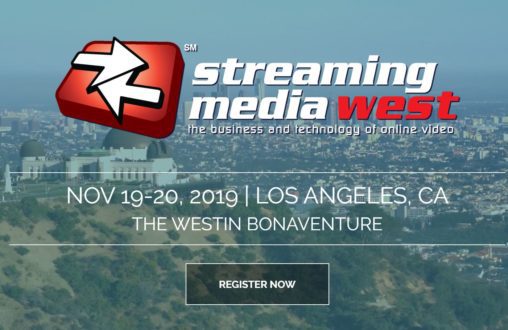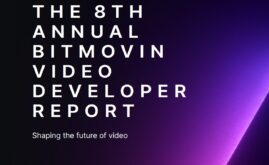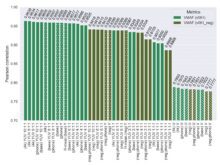Streaming Media West is coming up next month in the City of Los Angeles (as opposed to Huntington Beach where it’s been the last few years). Specifically, it’s at the Westin Bonaventure on November 19-20 (Tuesday/Wednesday) with pre-conference sessions on Monday the 18th. I’ll be my normal busy self with two pre-conference sessions and several presentations. Here are the dates, times, and descriptions.
Briefly, W1, Introduction To ABR Production & Delivery, is ideal for those new to streaming who need to get up to speed quickly and is a class I’ve never given at Streaming Media West before. W4, Objective Quality Metrics 2D & 3D: What They Are, How To Compute Them, & How To Use Them, is a wonky course on what objective metrics are and do and how to use them to benchmark encoders and codecs, and choose the optimal encoding presets and other encoding parameters. If you’re been yearning for a deep dive into tools like rate-distortion curves and BD-metrics, this is for you.
The sessions are pretty much self-explanatory.
Here’s a link to the sign-up page and for more information.
Contents
W1. Introduction To ABR Production & Delivery
Monday, November 18: 9:00 a.m. – 12:00 p.m.
This course helps those new to streaming media get familiar with relevant terms, concepts, and technologies. The session begins with a definition of terms like codecs, container formats, and adaptive bitrate (ABR) streaming, as well as encoding concepts like bitrate control (VBR, CBR) and frame types (I, B, and P). Then it details the key H.264 encoding parameters that impact quality and compatibility. Next up is adaptive streaming, including a review of available ABR technologies like HLS and DASH, how to formulate an encoding ladder, and how to use multiple DRMs to protect premium content. Then we review the technical requirements for ABR delivery to computers, smartphones and tablets, OTT devices, and smart TVs. We finish with a quick look at advanced codecs like HEVC, VP9, AV1, and VVC. You walk away knowing the technical requirements for delivering to all key platforms and an understanding of how to do so.
W4. Objective Quality Metrics 2D & 3D: What They Are, How To Compute Them, & How To Use Them
Monday, November 18: 1:30 p.m. – 4:30 p.m.
Every compression practitioner should understand what objective quality metrics do, how to compute them, and how to use them. This workshop guides attendees through the following steps: an introduction to metrics like PSNR, SSIM, SSIMplus, and VMAF, plus several 3D metrics; how to compute metrics with open source tools like FFmpeg and VMAFMaster, as well as third-party tools like the Moscow State University Video Quality Measurement tool and SSIMWave Quality of Experience Monitor; how to interpret the results; how to use these tools to choose a preset, choose the top rate for video files, and build an encoding ladder.
T101. HOW-TO: Fine-Tuning Your Encoding With Objective Quality Metrics
Tuesday, November 19: 10:30 a.m. – 11:15 a.m.
Choosing the number of streams in an adaptive group and configuring them is usually a subjective, touchy-feely exercise, with no way to really gauge the effectiveness and efficiency of the streams. However, by measuring stream quality via metrics such as VMAF, SSIMPlus, and others, you can precisely assess the quality delivered by each stream and its relevancy to the adaptive group. This presentation identifies several key objective quality metrics, teaching how to apply them using commercial and open-source tools and how to use them to fine-tune your adaptive bitrate ladders and encoding settings.
Speaker:
Jan Ozer, Principal, Streaming Learning Center and Contributing Editor, Streaming Media
VES105. Applications Of Per-Title Encoding
Tuesday, November 19: 4:30 p.m. – 5:15 p.m.
Per-title encoding techniques have progressed from theory to reality with real-world statistics to verify effectiveness. In this roundtable, panelists discuss how their technologies work and the overall impact on their encoding ecosystem and share case studies about how per-title encoding has saved bandwidth and/or improved quality of experience.
Moderator:
Jan Ozer, Principal, Streaming Learning Center and Contributing Editor, Streaming Media
Speakers:
Jon Dahl, CEO, Mux
Kieran Farr, Vice-President of Marketing, Bitmovin
Zohar Babin, VP of Platform and Growth, Kaltura
VES202. Hardware Transcoding Solutions For The Cloud
Wednesday, November 20: 11:30 a.m. – 12:30 p.m.
Hardware codecs in FFmpeg, like those from Intel and NVIDIA, deliver significant performance gains over x264/x265, but have a reputation for lower quality and use a completely different command set. This session benchmarks the performance and quality of these codecs and details the FFmpeg command syntax. Attendees learn when and how to use these hardware codecs in VOD and live encoding workflows.
 Streaming Learning Center Where Streaming Professionals Learn to Excel
Streaming Learning Center Where Streaming Professionals Learn to Excel









